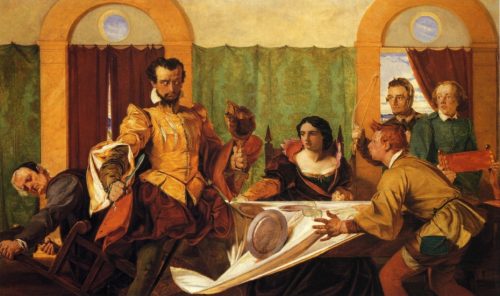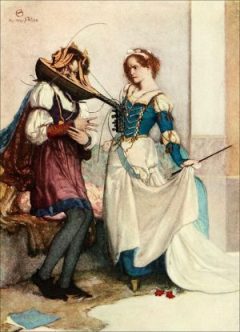 Title: The Taming of a Shrew.
Title: The Taming of a Shrew.
Author: ???
Earliest Extant Edition: 1594.
Genre: Comedy.
Language Difficulty Rating: 2 (not difficult).
Setting: Athens, Greece.
Style: mixed verse and prose.
WHY SHOULD I READ THIS PLAY?
- it is a genuinely entertaining little comedy.
- it is interesting to compare it to Shakespeare’s The Taming of the Shrew, which is a very different treatment of the same plot.
- it is a genuine parody, a comedy that satirizes the works of Christopher Marlowe.
- it is one of the easiest plays to read, making it a good starter play for anyone wishing to learn to read Elizabethan drama, and especially the works of William Shakespeare.
 The earliest known edition of the famous Shakespeare play The Taming of THE Shrew is from the 1623 Folio of the Bard’s plays. However, in 1594, an anonymous comedy, The Taming of A Shrew, was published, and seems to have been popular enough to have been reprinted in 1596 and 1607. In order to fully grasp and appreciate the significance of Shakespeare’s Shrew, it is important to read A Shrew as well, and in fact it is a very enjoyable exercise to read the two versions back-to-back (one should read A Shrew, with its simpler language, first). A second benefit of comparing the two versions is that one can learn to appreciate at a deeper level the incredible sophistication and creativity of Shakespeare’s writing.
The earliest known edition of the famous Shakespeare play The Taming of THE Shrew is from the 1623 Folio of the Bard’s plays. However, in 1594, an anonymous comedy, The Taming of A Shrew, was published, and seems to have been popular enough to have been reprinted in 1596 and 1607. In order to fully grasp and appreciate the significance of Shakespeare’s Shrew, it is important to read A Shrew as well, and in fact it is a very enjoyable exercise to read the two versions back-to-back (one should read A Shrew, with its simpler language, first). A second benefit of comparing the two versions is that one can learn to appreciate at a deeper level the incredible sophistication and creativity of Shakespeare’s writing.
Shakespeare’s Shrew is clearly the superior play, but that doesn’t mean A Shrew should be ignored. On the contrary, it is a well-organized and enjoyable, if not epic, little comedy, about a man who marries a wildcat of woman, and rather sadistically trains her to become an obedient and agreeable companion. The two versions of Shrew share not only the same plot and numerous individual pieces of business, but there are some sections of dialogue that are nearly identical.
So what exactly is the relationship between The Shrew and A Shrew? The short answer is, nobody knows for sure, and there is little agreement among academics. Every possible theory has been propounded: that A Shrew was an early draft of The Shrew, both written by Shakespeare; that Shakespeare based The Shrew on A Shrew; that the author of A Shrew based his play on The Shrew; that both the anonymous author and Shakespeare based their plays on an earlier original; and so on and so on.
The Mystery of the Many Marlowe Borrowings.
The most shocking feature of The Taming of a Shrew is that it is saturated with passages, lines, phrases and words lifted right out of the early plays of Christopher Marlowe, especially the Tamburlaine plays and Doctor Faustus. Why would anyone do this? The probable answer will be revealed in a moment.
Are There Any Theories as to Who the Anonymous Author was?
There are as many theories regarding the author of A Shrew as there are people who have commented on the mystery. The puzzle is of great interest because of what we might call the paradox of The Taming of a Shrew: (1) on the one hand, no self-respecting established dramatist would plagiarize so blatantly from Christopher Marlowe’s plays; (2) on the other hand, A Shrew is too good a play to be the work of a hack.
So How Should I Think About A Shrew as I Read It?
 The best answer (by your editor’s reckoning) is that A Shrew should be understood as a parody of Marlowe’s very famous works. Donna Murphy, in her 2012 book The Marlowe-Shakespeare Continuum, makes a convincing case that Marlowe himself wrote A Shrew as a self-parody, though it is possible that one of his contemporaries, such as Robert Greene, might have written it as well. You may read Professor Murphy’s analysis in Chapter Two here. Your humble editor leans toward the belief that Marlowe himself was the author of A Shrew, though as always we must leave open the possibility that more than one dramatist had a hand in writing the play.
The best answer (by your editor’s reckoning) is that A Shrew should be understood as a parody of Marlowe’s very famous works. Donna Murphy, in her 2012 book The Marlowe-Shakespeare Continuum, makes a convincing case that Marlowe himself wrote A Shrew as a self-parody, though it is possible that one of his contemporaries, such as Robert Greene, might have written it as well. You may read Professor Murphy’s analysis in Chapter Two here. Your humble editor leans toward the belief that Marlowe himself was the author of A Shrew, though as always we must leave open the possibility that more than one dramatist had a hand in writing the play.
Thinking of A Shrew as a parody helps to explain a lot of strange and random references in the play. It helps to explain the odd nature of the competition between two sisters as they try to outdo each other in a battle of rhetorical extremes to describe their deep love for their boyfriends. It explains why Aurelius would so suddenly and desperately fall in love with a girl he literally saw for only a few seconds pass before him.
Our Story: Polidor wants to marry the youngest daughter of the wealthy merchant Alfonso; but Alfonso will not give Polidor permission to do so until a husband can be secured for his oldest daughter, the ill-tempered Kate. Can Ferando be the one to change Kate into an obedient wife?
Download and Read The Taming of a Shrew:
On-line Reading:
Annotated Edition, pdf
White Background for Printing:
Annotated Edition, pdf
Theatre Script:
The Taming of a Shrew Script
_______________
Still-Familiar Words and Phrases that Research Suggests Appeared
in English Literature for the First Time in The Taming of a Shrew:
bloody nose
“go get a” (meaning to retrieve something)
piece of pie
refined sugar
burning rays
“stranger at the door”